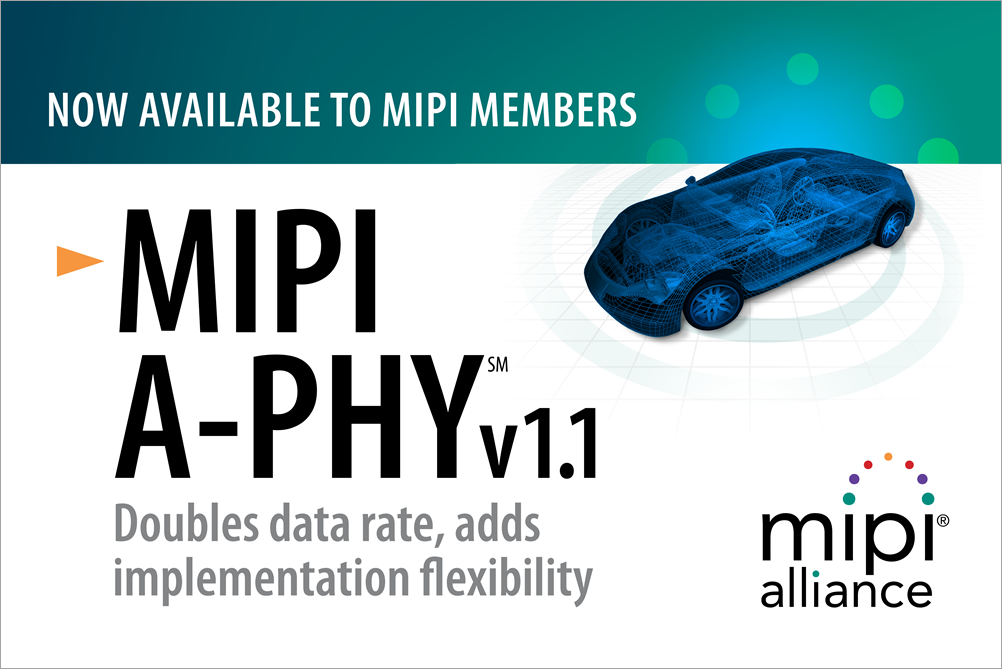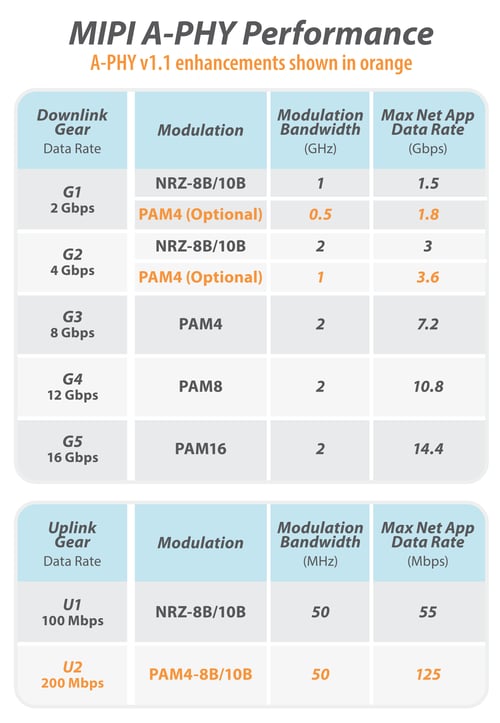2 min read
Updated A-PHY SerDes Interface Offers Faster Data Rates, Additional Implementation Options
![]() Sharmion Kerley, MIPI Director of Marketing and Membership
:
31 January 2022
Sharmion Kerley, MIPI Director of Marketing and Membership
:
31 January 2022

- News & Events
- News
- Blog
To kick off the new year, MIPI Alliance recently announced the adoption of A-PHYSM v1.1, the latest version of the automotive serializer-deserializer (SerDes) physical-layer interface, doubling the maximum downlink data rate from 16 Gbps to 32 Gbps, doubling the available uplink data rate and providing manufacturers with additional implementation options.
The new version gives OEMs and suppliers more flexibility to support rapidly growing requirements for automotive displays and sensors (cameras, lidars and radars). It enhances their ability to implement next-generation applications in advanced driver-assistance systems (ADAS), digital cockpits, in-vehicle infotainment (IVI) and autonomous driving systems (ADS).
MIPI A-PHY, originally released in September 2020, is the first industry-standard, long-reach, asymmetric SerDes interface to provide high-performance links between automotive image sensors and displays and their associated electronic control units (ECUs). A-PHY provides for asymmetric data links in point-to-point or daisy-chain topologies, with high-speed unidirectional data, low-speed bidirectional control data and optional power over a single cable. It has a reach of 15 meters, unprecedented reliability, high noise immunity and ultra-low latency. A-PHY also forms the foundation of MIPI Automotive SerDes Solutions (MASS), an end-to-end framework for connecting cameras, sensors and displays with built-in functional safety, security and data protection.
Expanded implementation options
A-PHY v1.1 is fully interoperable with v1.0, and devices using both specifications can coexist on the same network. It builds on the strengths of A-PHY v1.0 in several areas:
Optional PAM4 encoding
Optional PAM4 encoding for downlink gears G1 and G2 allows manufacturers to take advantage of the lower modulation bandwidth of PAM4, which enables sub-1 GHz operation. This makes it possible to migrate current platforms to A-PHY using legacy cables on current platforms or lower-cost cables on new platforms.
Doubled uplink data rate
A new uplink gear, U2, doubles the maximum uplink data rate from 100 Mbps to 200 Mbps. This option provides more bandwidth for command and control of automotive peripherals.

Support for Star Quad cables
Support for Star Quad (STQ) shielded dual differential pair cables introduces new cable configuration options that give OEMs more ways to implement A-PHY. STQ cables, which are already used in automotive applications, have four conductors providing dual differential pairs within one shielded jacket. This allows for two A-PHY ports over one cable, saving cost, weight and complexity compared with using two separate coaxial or shielded twisted-pair (STP) cables.
The support for STQ cables lends itself to several configuration options. Primarily, using both pairs of conductors as downlinks provides a total downlink bandwidth as high as 32 Gbps, which enables larger and higher-resolution cameras and displays, as well as daisy-chaining of more components from one ECU to reduce the number of cables.
A new asymmetric configuration, using one pair as a conventional A-PHY downlink of up to 16 Gbps and the other as a reverse downlink of up to 4 Gbps, lets OEMs use one cable instead of two for applications such as co-located displays and cameras. STQ cable support also allows for a symmetric configuration with a full-speed downlink of up to 16 Gbps and a reverse downlink of equal bandwidth.

What's next for A-PHY
Now that it has been adopted by the MIPI Alliance, v1.1 will also be brought forward for adoption as a standard by IEEE, the world's largest technical professional organization dedicated to advancing technology for humanity. Last year, IEEE adopted A-PHY v1.0 as IEEE 2977-2021.
Several resources are available for more information. Last week, A-PHY Working Group leaders gave an overview of these v1.1 enhancements and gathered feedback on requirements for the next version of A-PHY at the MIPI A-PHY Automotive Industry Forum (recording and slides available). In addition, session recordings are also available from last November's virtual Automotive Workshop, which provided in-depth education on the MASS framework. Finally, a white paper, "An Introductory Guide to MIPI Automotive SerDes Solutions (MASS)," offers an overview of each layer of the MASS framework.






